Colchicum, HermodactylMeadow SaffronSuranjan (Unani) Qui Shui Xian (TCM) |

|
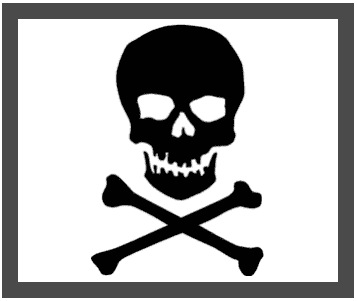
|
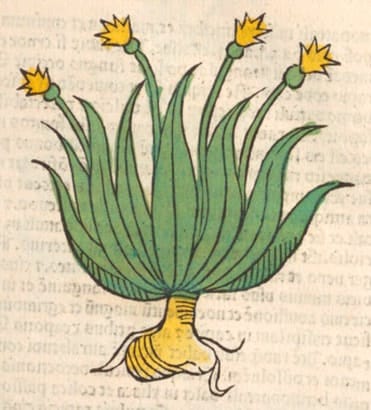 Herbarius latinus, Petri, 1485
Herbarius latinus, Petri, 1485 |
|
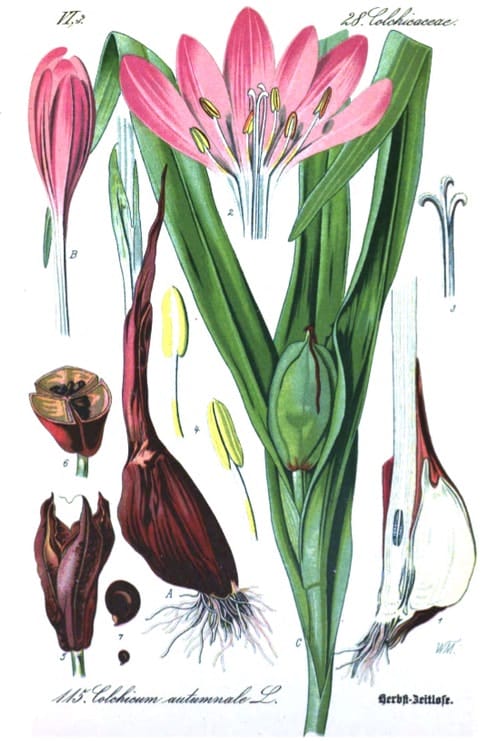 Flora von Deutschland, Kohler, 1886
Flora von Deutschland, Kohler, 1886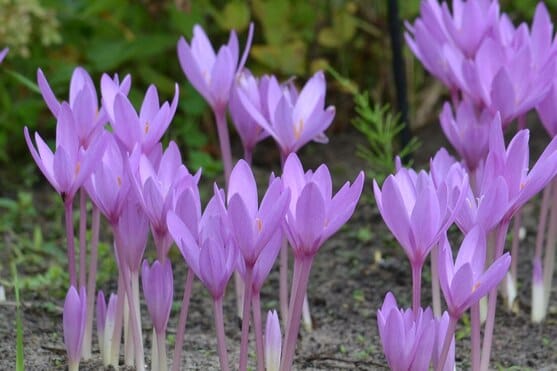 Colchicum autumnale
Colchicum autumnale(Photo by Joanna Boisse) (Wikimedia)
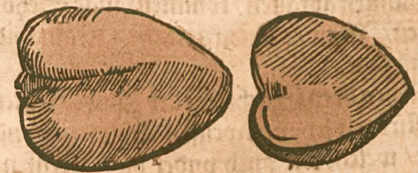 Official Colchicum corm
Official Colchicum cormKrauterbuch, Lonitzer, 1578
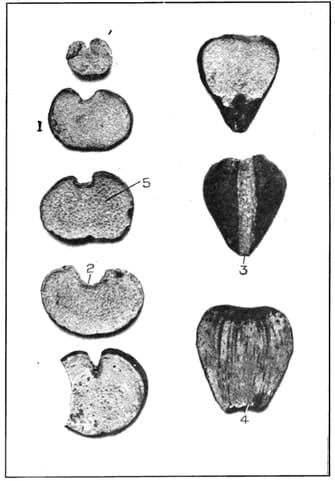 COLCHICUM CORMS
COLCHICUM CORMS1. Reniform section of the corm. 2. Groove formed by the growing
stem. 3. Longitudinal section showing the groove formed by the
growing stem. 4. Longitudinal section showing parallel lines
of resin tissue. 5. Round resin masses.
Squibb’s Atlas of the Official Drugs, Mansfield, 1919
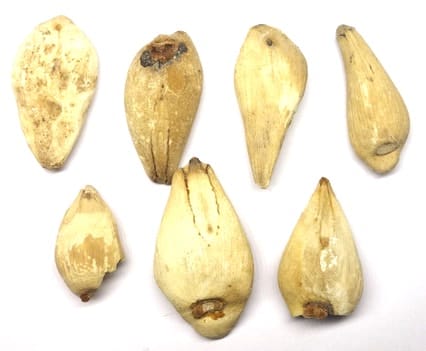 Sweet Colchicum
Sweet Colchicum(Calcutta Unani College, Adam, 2019) |
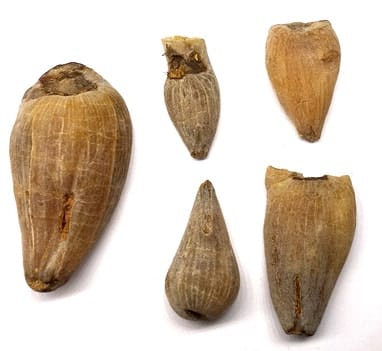 Bitter Colchicum
Bitter Colchicum(Calcutta Unani College, Adam, 2019) |
Botanical name:
Colchicum autumnale is the traditional source.
Others used as a source of Colchicum include C. luteum, C. bulbocodioides (Egyptian), C. illyricum, and C. variegatum.
C. variegatum has been suggested as the principle ancient source of Hermodactyl.
In India and Unani medicine, two varieties of Colchicum are used; a ‘Sweet’ or ‘tasteless’, and a ‘Bitter’:
- Sweet Suranjan: Merendera persica (syn. C. aitchisonii): dried pieces are white internally, hard, powdery, sweet. This is the only form used internally today, as it is milder in effect.
- Bitter Suranjan: Colchicum luteum.: smaller, bitter taste, striped appearance, reddish or grayish tint. This is only used externally today.
Avicenna mentioned White, Red and Black varieties, the latter 2 being poison.
Some Unani sources have stated that C. autumnale produces the Sweet variety, while C. luteum supplies the Bitter variety. This appears to be incorrect however.
Parts used:
Root (Corm); more recently the Seed
Merendera persica is now most commonly used, and is the only form used internally. Whenever “Colchicum” is listed in an internal formula, this is the form that should be used. These are small bulbous roots, the shape of a Heart, as big as a walnut, but flatter; pale externally, white within; sweet taste.
“The best kind of Hermodactyle should have a white exterior and white interior and it should not be brittle. Both red and black varieties are inferior in quality”. (Avicenna)
Temperature & Taste:
Hot, dry. Bitter, Sweet. Toxic
“Hermodactyle is hot and dry up to Second degree … Some experts believe the White variety to be mild in Hotness and all other varieties to be Strong in potency [Hot].” (Avicenna)
Uses:
1. Purge Wind, Damp and Phlegm, Eases Pain:
-Damp and tough, phlegmatic humors from the whole body, esp. the Joints
-Gout, Arthritis, Rheumatism, especially of the hands and feet, Sciatica
-obstinate skin diseases with Wind and Damp (itchiness and weeping)
-“It is also a good remedy for all kinds of Arthralgia”. (Avicenna)
-“The white variety is good for treating chronic Wounds” (Avicenna)
2. Clears Cold-Phlegm:
-effective to cleanse Phlegm when other medicines have failed
-some found it useful in obstinate Asthma
3. Warms the Kidneys:
-“Increases Sexual desire”. (Avicenna)
4. Externally:
–Avicenna recommended a plaster for Gout. Gerard recommended a plaster with Barley meal and Egg white.
-A paste of the fresh bulb is applied for chronic and indurated tumors.
–Mesue applied it topically to foul and chronic Ulcers.
-applied externally with Barley Meal and Egg White to Gout and Joint pain
-applied to Warts, Corns and Venereal diseases
Comment:
‘Colchicum’ embrace 2 different roots. Unani recognises Sweet and Bitter varieties. In the West, doses range from 125mg up to half a dram as a starting dose, whereas doses of as little as 1 gram have apparently killed Children. The Sweet variety is more gentle and can be used in larger doses, whereas the Bitter variety is more potent and highly toxic in excess.
Dose:
ROOT: 125–500mg, commonly 250mg
SWEET ROOT: half–1 dram in powder, 2–4 drams in infusion (Pomet)
SEED: 125–300mg, commonly 200mg
Of the TINCTURE of the SEED (2 oz to 1 pint of 60% Alcohol): 5-15 drops; 15 parts of the tincture can be mixed with 85 parts of simple syrup and given in doses of 1–2 teaspoonfuls, 3 or 4 times daily.
Of the FLUID EXTRACT of COLCHICUM (BP): 0.12-0.3 mls (1-5 drops)
An Oxymel of Colchicum was prepared with 10 parts acid (vinegar) tincture with 20 parts Honey, the dose being half–1 teaspoonful
Correctives:
1. Ginger, Black or Long Pepper, Aniseed, Cumin, Cinnamon, Spikenard, Mint, Clove, Mace, or Mastic. These things stop it hurting the Stomach while conveying it to the joints. (Unani, West)
2. Mesue said 1 dram of Ginger, Mastic or Cumin
3. Sweet Variety is corrected with Tragacanth and Saffron (Unani)
Substitutes:
1. Merendera, the ‘Sweet Colchicum’ is safer to use but is regarded as having similar effects to Colchicum.
2. Narcissus tazetta is apparently used as a substitute for Bitter Colchicum.
3. ‘Equal weight of Senna leaves and half quantity of Indian blue bdellium act as the substitute for Hermodactyl in cases of arthralgia’. (Avicenna)
Main Combinations:
1. Arthritis, Arthralgia, Gout:
I. Colchicum with Yellow Chebula, Bdellium and Turbith (as in Pills of Colchicum of Unani)
II. Ginger, Colchicum (1 part each), Aloe (2 parts), form Pills. (Modern Unani Formula)
iii. Colchicum, Scammony, Saffron, Senna, Chebula, Turpeth, Almond (as in Tong Zhi Su Run Jiang Capsule of Uyghur Medicine)
2. Arthritis, Rheumatism, Colchicum with Agaric, Turbith, Cassia wood, Indian Spikenard, Clove, Aloeswood, Ginger, Mastic, Fennel seed, Aloe (as in Arthritic Pills of Nicholas)
3. Chronic Gout:
i. Colchicum with Aconite and Guaiacum
ii. Colchicum with Guaiacum, Sassafras, Ground Pine, Germander, Agrimony, Sage, Betony, Dodder
4. Rheumatism, Colchicum with Rhubarb, Cardamon, Cinnamon, Guaiacum (as a tincture)
5. Gout and Rheumatism:
i. Colchicum with Bryony, Gentian, Camomile, Betony
ii. Ecletic physicians combined tinctures of Colchicum and Bryony
7. Chronic Arthritis, combines Colchicum with purgatives medicines such as Bryony, Turbith, Agaric, Polypody, Rhubarb, Senna, Black Hellebore, Colocynth, or Dwarf Elder to which correctives and enhancing medicines such as Aniseed, Fennel seed, Cinnamon, Saffron, St. Johns wort, Ground Ivy, Rosemary etc.
8. To increase sexual desire, Colchicum, Ginger, Mint, Cumin (Avicenna)
9. Chronic Ulcers, Colchicum powder with Honey applied. (Mesue)
Major Formulas
Pills of Colchicum (Mesue) (Habb E Suranjun)
Pills of Colchicum Greater (Habb E Suranjun Kalan)
Pills for Arthritis (Nicholas)
Powder for Arthritis of Turner
Powder for Warts
Electuary for the Joints (Unani)
Electuary of Polypody
Electuary of Clove and Costus (Caryocostinum)
Cautions:
1. Avoid overdose.
2. Not use during Pregnancy or in Children
3. Not used in Yin deficiency
4. Use should be discontinued if there is severe catharsis.
5. “Hermodactyle is not suitable for the Stomach and weakens it.” (Avicenna)
Toxicity:
1. Colchicum is very toxic in overdose. As little as 1 gram of the seeds can kill a child. Poisoning can include nausea, vomiting, bloody diarrhea, convulsions, and death in severe cases. A number of cases of severe poisoning and death are still reported due to the use of Colchicine in modern medicine.
2. Colchicum toxicity resembles Arsenic poisoning.
3. Merendera is considered far less toxic and is the only form used internally. Colchicum is still used externally.
–Accidental poisoning with autumn crocus (Colchicum autumnale): a case series.
–Studies on hepatotoxicity and toxicokinetics of colchicine.
–Colchicine poisoning.
Antidotes:
1. Dioscorides said Cows Milk is a good antidote.
2. In more modern times, emetics, tannin and demulcent drinks
Main Preparations used:
Extract, Honey, Wine, Tincture, Oxymel
1. Extract of Colchicum:
i. Fresh Colchicum bulbs, any quantity. Bruise, express the juice, and evaporate immediately in a water bath with a moderate heat.
2. Honey of Colchicum:
i. Bruised Colchicum bulbs (2 oz.), Water (3 lbs.). Boil slightly for a few minutes, then steep 2 days. Express, and add Honey (1 ½ lbs.). Clarify and boil to the thickness of a syrup. (Pharmacopoeia Gallica, 1818)
3. Wine of Colchicum:
i. Sliced Colchicum bulbs (2 oz.), Sherry wine (4 oz.). Macerate, filter. (Pharmacopoeia Gallica, 1818)
4. Tincture of Colchicum bulb:
i. sliced Colchicum bulb (1 part), Proof Spirit (3 parts). Digest 6 days, then strain.
ii. sliced Colchicum bulb (1 part), Alcohol 20% (4 parts). Digest 6 days, then strain. (Niemann)
5. Tincture of Colchicum Seeds:,
i. Colchicum seed (2 oz.0, Proof Spirit (1 pint). Macerate 14 days, strain.
6. Oxymel of Colchicum:
i. Colchicum bulbs, sliced (1 oz.), Distilled Vinegar (1 pint), Clarified Honey (2 pints). Steep the bulbs in the vinegar for 2 days; then express strongly then add the honey and boil gently to the consistency of Honey, stirring frequently with a wooden spoon. (Dublin)
An article on the History of Colchicum use: Colchicum: the panacea.
Of Hermodactyl
|
‘Some suppose it to be our Daffodils, and indeed I do take it to be a kind of them, but the Greeks do call their Hermodactilon, Ephemeron, and Colchicon, of the place where it groweth. And although this root may kill a man in one day (as also our Daffodils do ercitate a flux or lask in the belly even till the blood do follow) yet hath it his use… This root shall be digged up out of the earth in the beginning of the Summer, and those that are sappiest | and whitest within, shall be reserved. Those that are withered and soft have lost their virtue: such as grow in wet, waterish and low ground are very venomous. And albeit, that they be very clean and dry, yet shall they not be used in half a year, and are very seldom in request… Cinnamon, Ginger, Mastic, Long Pepper do greatly correct their venomous quality: they are given in Vinegar of Squills, Honey of Roses or Oxymel’. (Wirtzung) |
|
‘Dioscorides drew attention to the poisonous properties of Kolchicon, which he stated to be a plant growing in Messenia and Colchis. This character for deleterious qualities seems to have prevented the use of colchicum both in classical and mediaeval times. Thus Tragus (1552) warns his readers against its use in gout, for which it is recommended in the writings of the Arabians. Jacques Gre Vin, a physician of Paris, author of Deux Livres des Venims, dedicated to Queen Elizabeth of England, and printed at Antwerp in 1568, observes— “ce poison est ennemy de la nature de l’homme en tout et par tout.” Dodoens calls it perniciosum Colchicum; and Lyte in his translation of this author (1578) says— “Medow or Wilde Saffron is corrupt and venomous, therefore not used in medicine.” Gerarde declares the roots of “Mede Saffron” to be “very hurtfull to the stomacke.” Wedel published in 1718, at Jena, an essay De Colchico |
veneno et alexipharmaco, in which, to show the great disfavour in which this plant had been held, he remarks,— “hactenus . . . velut infame habitum et damnatum fuit colchicum, indignum habitum inter herbas medicas vel officinales . . .” He further states that, in the 17th century, the corms were worn by the peasants in some parts of Germany as a charm against the plague. In the face of these severe denunciations, it is strange to find that in the London Pharmacopoeia of 1618 (the second edition), “Radix Colchici,” as well as Hermodactylus, is enumerated among the simple drugs; and again in the editions of 1627, 1632 and 1639. It is omitted in that of 1650, and does not reappear in subsequent editions until 1788, when owing to the investigations of Storck (1763), Kratochwill (1764), De Berge (1765) Ehrmann (1772), and others, the possibility of employing it usefully in medicine had been made evident.’ (Pharmacographia, Fluckiger & Hanbury, 1879) |
